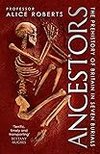
Saved by Margaret Leigh
Ancestors

Saved by Margaret Leigh
If we want to understand how our genomes today have been shaped by diseases in the past, anything before the British Bronze Age is largely irrelevant. This is because other studies have already suggested that there was a huge upheaval in Britain at this time, with a significant turnover of ancestry – a widespread population replacement. ‘The people
... See moreAs Harold Blackham urged, the most human response to death – the humanist response – is to accept that someone is gone, and remember their life. Not to fixate on their corpse.
‘Any diseases in particular that you’re going to focus on? Any burning questions?’ I wonder. ‘I just want all the pathogens! All of the pathogens, all of the time!’ Pooja laughs. ‘But seriously, I’m very interested to see how diseases change when agriculture emerges in the Neolithic – when people begin to live in larger, denser communities. And I
... See moreBut the picture is too neat, too reassuring. Because we have those names, we feel that we have a sense of understanding, which the history does not in fact give us. What does ‘Dumnonii’ actually mean? Does it just refer principally to a geographic area? Or an ethnic group? Or simply a political grouping? (And we cannot escape the fact that such
... See moreThe era of ancient genomics, though, suddenly provides us with the opportunity to explore these questions of hierarchy and kinship in a very detailed way that has simply not been possible before: tomb by tomb, hill by hill, valley by valley.
In the early eighteenth century, the Welsh antiquarian Edward Lluyd – who was Keeper of the Ashmolean Museum – undertook a pioneering survey of languages. Setting English aside, he noted the similarities between the other languages spoken across the British Isles – and that of Brittany. He called these languages ‘Celtic’ – which really just meant
... See more‘We think that it was to produce a container,’ she said. ‘It was a cup.’ This was deeply strange. I wanted to question it, to doubt it. But there was the evidence in front of me, and I couldn’t think of any other explanation for the way this skull had been carved, sculpted. It certainly didn’t seem to be purely functional – it wasn’t just about
... See moreBut against that background picture of health and disease was unequivocal evidence of violent injury around the time of death. Skulls had been smashed in with blunt weapons – probably adzes; legs had been hacked at, fracturing fibulae and tibiae. That focus on the legs suggests the attackers were not only interested in dealing fatal blows to their
... See more‘Into the underland we have long placed that which we fear and wish to lose, and that which we love and wish to save.’ Robert Macfarlane, Underland: A Deep Time Journey, 2019